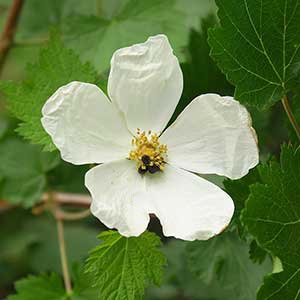Rubus bartonianus
Rubus niveus
Barton's raspberry, bartonberry
Hill raspberry, Mysore, snowpeaks, snowpeaks raspberry
erect, sparsely short-hairy, glabrescent, eglandular, not pruinose.
biennial, erect to arching, often scrambling, sparsely hairy, glabrescent, eglandular, strongly pruinose;
prickles sparsely to moderately dense, hooked to reflexed, stout, 3–9 mm, broad-based.
deciduous, simple;
stipules lanceolate, 4–6 mm;
blade cordate to broadly ovate, (2–)2.5–4(–5) × (2.5–)3.5–4.5(–5.5) cm, base deeply cordate, 3–5-lobed, lobe apices acute to obtuse, margins coarsely doubly dentate, abaxial surfaces glabrous or sparsely hairy, eglandular or sparsely stipitate-glandular.
deciduous, pinnately compound;
stipules linear-lanceolate, 4–8 mm;
leaflets (3–)5–7(–9), terminal ovate to broadly ovate, 4–6.7 × (2.4–)3.4–5.4 cm, base shallowly cordate, sometimes shallowly 3-lobed, margins coarsely serrate to doubly serrate, apex acute to short-acuminate, abaxial surfaces with scattered, reflexed, broad-based prickles on midveins, densely white-tomentose, eglandular.
1-flowered.
terminal and axillary, 1–11-flowered, cymiform.
moderately hairy, eglandular or sparsely stipitate-glandular.
prickles absent or sparse, erect to reflexed, pubescent, eglandular.
bisexual;
petals white, obovate, (15–)20–25 mm;
filaments filiform;
ovaries glabrous, styles clavate, villous.
bisexual;
petals pink to magenta, broadly obovate to orbiculate, 4 mm;
filaments laminar;
ovaries densely hairy.
deep red, hemispheric, to 1 cm;
drupelets 10–30, coherent, separating from torus.
purple-black, hemispheric to globose, 0.5–1.5 cm;
drupelets 50–75, coherent, separating from torus.
= 14.
Rubus bartonianus
Rubus niveus
Of conservation concern.
Rubus bartonianus is distinguished from the other flowering raspberries within its geographic range by its erect, unarmed stems, relatively small, simple leaves with acute to obtuse lobes, deeply cordate bases, sparsely hairy or glabrous abaxial surfaces, relatively large flowers with white petals, and densely long-hairy, clavate styles. The leaves superficially resemble those of Acer glabrum or some species of Ribes.
Rubus bartonianus is most similar to R. neomexicanus but especially R. deliciosus. The species is known only from the Snake River Canyon of Idaho and Oregon.
(Discussion copyrighted by Flora of North America; reprinted with permission.)
Rubus niveus is distinguished from other raspberries by its pinnately compound leaves with 5–7 leaflets, ovate to broadly ovate terminal leaflet, leaflets with prickles on the midvein, and pink to magenta, broadly obovate to orbiculate petals. The species was introduced into southern Florida around 1949 from seeds obtained in Kenya and quickly became popular for its fruits, which are edible fresh or frozen and are often used in preserves, pies, and tarts (J. F. Morton 1987).
(Discussion copyrighted by Flora of North America; reprinted with permission.)


